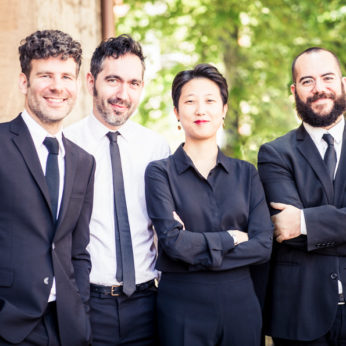Composer: Johann Abraham Peter Schulz (b. 1747 - d. 1800)
Performance date: 26/06/2023
Venue: St. Brendan’s Church
Duration: 00:09:39
Recording Engineer: Gar Duffy, RTÉ
Instrumentation: vn, hpd
Instrumentation Category:Baroque Ensemble
Artists:
Ensemble Diderot (Johannes Pramsohler, Roldán Bernabé [violins], Alexandre Baldo [viola], Gulrim Choï [cello], François Leyrit [bass], Jadran Duncumb [lute], Philippe Grisvard [harpsichord]) -
[Baroque Ensemble]

The concept of programme music surfaces and resurfaces throughout music history. The idea behind it was to demonstrate that instrumental music could have a meaning outside itself. Eighteenth-century aesthetic theory was rational, and music – especially instrumental music – was generally undervalued because it could not be translated into words. Graun and Bach set out to show that music could represent a dialogue as well as emotional states. For those who could not understand the language of music, he offered a translation.
Biber’s Mystery Sonatas and Vivaldi’s Four Seasons are other early examples where every line of music has an accompanying text. Nearer our own time examples could include Schoenberg’s Verklärte Nacht and Richard Strauss’ Symphonic Poems. It is interesting to note that Soviet musicologists were anxious to explain Shostakovich Symphonies by attaching programmes to them.
The Melancholicus & Sanguineus pairing is a greatly simplified form of programme music, where two characters, one melancholic, introverted and gloomy, the other hot-headed, extrovert and optimistic coverse with each other. The two composers in this concert, Johann Graun and CPE Bach, use this contrast of temperaments as the rationale for contrasting musical ideas. Graun’s sonata with the title Melancholicus & Sanguineus provided the inspiration for CPE Bach’s fully fledged working out of the concept. CPE actually provided a text describing each development in the conversation, which is inevitably won by the overbearing Sanguineus as the last movement was never going to be melancholic.
Irrespective of the argument, Graun’s Trio Sonata is a tremendous piece set in the Berlin format of slow-fast-fast(er). Johann Gottlieb Graun was cerntmaster for Frederick the Great’s orchestra in Berlin, which now rivalled Dresden in the quality of its musicians. This music was written for his top performers, the first vilin part is spectacular in all movements, but especially in the final Allegro di molto and the soaring solo melody in the middle movement.
Johann Philipp Kirnberer studied for two years with Bach in Leipzig. He even invented a way of writing music that the reminds the modern reader of John Cage. He created a table of melodies and then threw dice to determine which melody should be chosen! His short D minor Trio Sonata begins with a swaying Andante leading to a cheerful Allegro fugue and a concluding Presto.
Johann Gottlieb Goldberg is famous on account of his prodigious harpsichord skills and his role as chamber harpsichordist for Count von Keyserling, who had recognised his talent when he was only ten. The Count arranged for Goldberg to study with Bach in Leipzig and later with Bach’s eldest son Wilhelm Friedmann. As Bac’s biographer recounted, the Count suffered from insomnia and commissioned Bach to compose a set of Variations that young Goldberg could play for him at night. Thus did the fourteen-year-old harpsichordist earn immortality. Although he died very young, Goldberg was also a composer. His C major Trio Sonata was once thought to be by Bach himself. It opens with an Adagio blessed with a disarmingly sweet violin melody that would not have disgraced the master himself. The alla breve that follows features lightly dancing violins over a steady bass line. The lovely melody of the brief Largo acts as an introduction to the obligatory presto Gigue, always cheerful and demanding much instrumental agility.
Johann Abraham Peter Schulz is the youngest of the five composers that Ensemble Diderot feature in today’s programme. It is curious to think of trio sonatas still being written during the lifetime of Mozart and Beethoven. Schulz was a student of Kirnberger, who found him a job as accompanist for a Polish princess, which led him on a much-travelled career. Schulz’ A minor Trio Sonata is brief but charming, the opening Allegretto is quietly impressive, relying on dynamic variety to stretch out its main theme. The even shorter Adagio alternates solemn maestoso statements with tiny dancing trios. The finale abjures the normal helter-skelter gigue in favour of a slightly ponderous step dance.
Francis Humphrys
Copyright © 2025 West Cork Music. All rights reserved.
Designed and developed by Matrix Internet